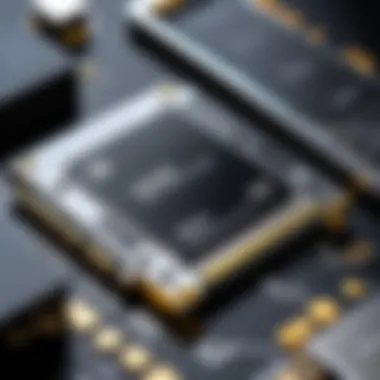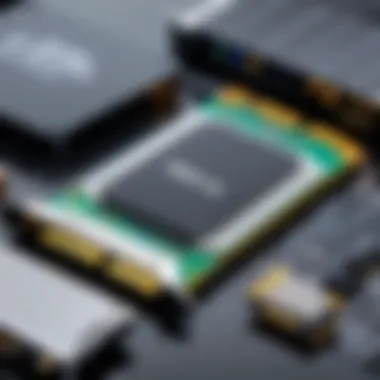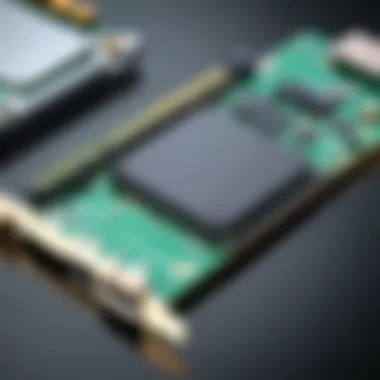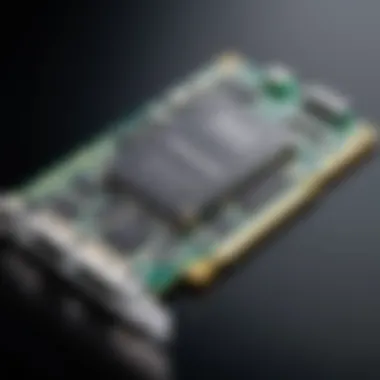Exploring M.2 SSD PCIe Adapters: A Complete Guide


Intro
In today's era of rapidly evolving technology, storage solutions have become a pivotal aspect of computing performance. M.2 SSD PCIe adapters are at the forefront of this evolution, providing users with enhanced speed and efficiency. This guide aims to dissect the various dimensions of these adapters, covering their types, performance benchmarks, installation processes, and more. With a comprehensive understanding, readers can make educated choices regarding their storage needs.
Product Overview
M.2 SSD PCIe adapters serve as a crucial interface for connecting storage devices to a motherboard. These adapters capitalize on the PCIe (Peripheral Component Interconnect Express) bus, allowing for higher data transfer rates compared to traditional SATA connections.
Key Features
- Compatibility: M.2 adapters support various SSD formats, including SATA and NVMe, making them versatile across different systems.
- Speed: Utilizing PCIe 3.0 or 4.0, these adapters can significantly enhance data transfer speeds, sometimes exceeding 7000 MB/s with NVMe drives.
- Form Factor: Compact design of M.2 slots allows for more efficient space usage, making it suitable for laptops and desktops alike.
Technical Specifications
- Interface: PCIe 3.0 / 4.0
- Connector Types: M-key, B-key, and B+M key
- Supported Capacities: Up to 8TB, depending on the SSD used
Pricing Information
Pricing for M.2 SSD PCIe adapters varies based on features and specifications. Simple models can start around $15, while more advanced versions designed for high-performance gaming or professional workloads can exceed $50.
Performance Analysis
Understanding the performance implications of M.2 SSD PCIe adapters is essential for users seeking faster storage solutions.
Benchmark Results
Benchmarks often show that NVMe drives connected through M.2 adapters outperform traditional SATA SSDs. On average, an NVMe SSD can deliver read speeds up to 5000 MB/s, which is significantly faster than the 600 MB/s limit of SATA SSDs.
Real-World Use Cases
Gamers and content creators benefit greatly from these adapters. Games load quicker and large files transfer faster, improving overall productivity. For instance, video editing software can render footage more efficiently when utilizing fast SSDs.
Comparison with Competitors
When compared to other storage options, like external SSDs or traditional HDDs, M.2 SSDs paired with PCIe adapters excel in speed and reliability. They also provide better thermal management due to their design.
Installation and Setup
Installing an M.2 SSD PCIe adapter requires a few essential tools and a methodical approach to avoid common pitfalls.
Required Tools and Components
- Compatible M.2 SSD
- Screwdriver
- Thermal paste (if necessary)
- Anti-static wrist strap (recommended)
Step-by-Step Installation Guide
- Power Off the System: Ensure the computer is turned off and unplugged.
- Open the Case: Remove the side panel of the computer case.
- Locate the M.2 Slot: Identify the M.2 slot on the motherboard.
- Insert the SSD: Align the notches and insert the SSD at a slight angle. Press down gently.
- Secure the SSD: Fasten the SSD with the provided screw.
- Close the Case: Reattach the side panel and power on the system.
Troubleshooting Common Issues
- If the SSD is not recognized in BIOS, ensure it is properly seated in the M.2 slot.
- Check for motherboard compatibility if issues persist.
Pros and Cons
Understanding the advantages and limitations of M.2 SSD PCIe adapters helps users make informed decisions.
Advantages of the Product
- Superior speed compared to traditional storage solutions
- Compact design saves physical space inside the case
- Multi-device compatibility extends usability
Disadvantages or Limitations
- Some motherboards may lack M.2 slots
- Higher cost for NVMe drives compared to SATA SSDs
Who It’s Best Suited For
Tech enthusiasts, gamers, and professionals who require high-speed data transfer and performance will find M.2 SSD PCIe adapters particularly beneficial.
Final Thoughts
Summary of Key Points


- M.2 SSD PCIe adapters offer superior data transfer rates.
- Installation can be done with basic tools and a systematic approach.
- They are versatile and suited for various types of users.
Recommendations for Potential Buyers
Buyers should assess compatibility with their system and consider the specific performance requirements before purchasing.
Future of the Technology or Product Line
As technology advances, we can expect even faster speeds and improved design from M.2 SSD PCIe adapters, catering to the ever-increasing demand for efficient storage solutions.
Preamble
In the current landscape of computing, storage speed and efficiency hold paramount importance. The demand for enhanced performance motivates users to upgrade their storage solutions. This is where M.2 SSD PCIe adapters come into play, bridging the gap between traditional storage technologies and the need for cutting-edge performance. This article serves as a comprehensive guide to understanding these adapters, their types, benefits, and compatibility considerations. Each section aims to equip readers with valuable insights for informed decision-making in their storage upgrades.
Understanding M.
Technology
M.2 technology represents a significant advancement in the realm of solid-state drives. Unlike older interfaces such as SATA, which constrain data transfer speeds, M.2 SSDs leverage a direct connection to the motherboard. This connection enables faster data access and efficient space utilization. M.2 drives can support multiple protocols including SATA and PCIe, highlighting their versatility.
Additionally, M.2 has various physical sizes, typically measured in millimeters, such as 2242, 2260, and 2280. This sizing caters to different uses in different devices, from ultrabooks to high-performance desktops. Users must understand these dimensions to ensure compatibility with their hardware.
The Role of PCIe in Data Transfer
The PCIe (Peripheral Component Interconnect Express) interface is crucial for modern data transfer. It offers significantly higher bandwidth compared to other interfaces, potentially reaching up to 32 GT/s in the latest versions. M.2 SSDs utilizing PCIe can employ multiple lanes – typically one, two, or four – which directly translates to improved data transfer rates, especially in demanding applications like gaming or data analysis.
By optimizing how data packets move between components, PCIe substantially reduces latency. This feature is vital for applications requiring rapid data retrieval and storage, making M.2 SSDs with PCIe an attractive option for users seeking high-performance solutions.
In summary, the synergy between M.2 technology and PCIe protocol enables the creation of high-speed, efficient storage solutions that redefine performance in modern computing.
Types of M.
SSD PCIe Adapters
Understanding the types of M.2 SSD PCIe adapters is critical for anyone looking to enhance their computing experience. The diverse options available cater to varying needs and setups, ensuring that users can find an adapter that fits their specific requirements. Choosing the right adapter can lead to improved performance, optimized space, and efficient storage solutions in both desktop and laptop environments.
Key M.
Interface Types
M.2 SSD PCIe adapters come in various interface types, which are essential in determining compatibility with different SSDs. Here are the main M.2 interface types:
SATA vs.
NVMe
- SATA: Older and more common, SATA is limited in speed. It can transfer data at a maximum of 6 Gbps.
- NVMe: Offers superior speed and efficiency, utilizing the PCIe lanes. It can achieve much higher throughput, often exceeding 3500 MBps, making it suitable for modern applications.
B-Key, M-Key, and B+ Key
- B-Key: Supports SATA and PCIe x2. Suitable for some SSDs but has limitations on speed.
- M-Key: Supports PCIe x4, allowing for maximum bandwidth, making it ideal for high-performance SSDs.
- B+M Key: The versatility of this key allows both B-Key and M-Key SSDs to connect. However, the performance still varies based on the utilized key.
Understanding the ramifications of these interface types is crucial when selecting the best M.2 PCIe adapter. It impacts not only the compatibility of the SSD but also its performance potential.
Single vs.
Multi-Slot Adapters
When choosing an M.2 SSD PCIe adapter, users can choose between single and multi-slot designs. Each offers distinct advantages.
Single-Slot Adapters
- Generally compact, single-slot adapters are suitable for systems with limited space. They are a great choice for users with only one SSD to install, making the setup simpler.
- Available in various forms, they often feature additional cooling solutions to optimize performance under load.
Multi-Slot Adapters
- Multi-slot adapters allow for several SSDs to be connected simultaneously. This is particularly beneficial for users needing extensive storage or for those involved in video editing, gaming, or large data processing tasks.
- They often come with built-in thermal management features, to ensure optimal performance even when multiple drives are in use.
The choice between single and multi-slot adapters ultimately depends on user needs. For casual users, a single-slot option may suffice, while tech enthusiasts and professionals may lean towards multi-slot solutions for flexibility and performance.
Choosing the right type of M.2 SSD PCIe adapter can significantly affect your system's performance and efficiency. Always consider your specific needs and future expansion plans when making a decision.
Benefits of Using M.


SSD PCIe Adapters
The integration of M.2 SSD PCIe adapters in modern computing brings a spectrum of advantages that can significantly enhance both user experience and system performance. Understanding these benefits is crucial for anyone considering an upgrade to their existing storage solutions. In the following subsections, we will delve into the most pivotal factors that make M.2 SSD PCIe adapters an attractive option for various user needs.
Enhanced Performance Metrics
M.2 SSD PCIe adapters are designed to leverage the high-speed capabilities of the PCIe interface, enabling data transfer rates that can surpass other storage technologies. The PCIe 3.0 standard supports transfer speeds of up to 32 Gb/s, while PCIe 4.0 further amplifies this to 64 Gb/s. The enhancement in performance ensures faster boot times, reduced application load times, and overall smoother system operation.
Moreover, M.2 SSDs can utilize multiple lanes for data transmission, maximizing efficiency. This means that different tasks can be handled simultaneously without a drop in speed. Especially for activities like gaming, video editing, or running virtual machines, these performance metrics translate to a more responsive system under heavy load. This makes M.2 SSD PCIe adapters an excellent choice for tech enthusiasts and professionals alike.
Space Saving and Aesthetics
One notable advantage of M.2 SSD PCIe adapters is their compact design. Unlike traditional hard drives or even some SATA SSDs, M.2 drives have a sleek form factor that contributes not only to physical space-saving but also enhances the aesthetics of computer builds. With the rising popularity of custom builds, many users prioritize a clean and efficient workspace.
Additionally, this compactness allows for better airflow within the case, which can aid in maintaining optimal operating temperatures. Users who build their systems for both performance and appearance will find that M.2 SSD PCIe adapters can fit seamlessly into their setups, ultimately creating a more organized and visually appealing configuration.
Simplified Installation Processes
Installing an M.2 SSD PCIe adapter is often simpler and more straightforward than traditional methods of adding storage drives. Most motherboards feature dedicated M.2 slots, which reduce the need for cumbersome cables and additional mounting hardware. Users can simply slot the M.2 drive into place, secure it, and connect any necessary power cables if required.
The installation process is typically straightforward, resulting in less time spent on setup and more time enjoying the benefits of the upgraded storage. This ease of installation is particularly appealing to casual consumers who might not have extensive technical knowledge. Consequently, this plays a significant role in the decision-making process when considering upgrading storage options for their systems.
In summary, the shifts towards higher performance metrics, space efficiency, and simplified installation make M.2 SSD PCIe adapters a compelling choice for a wide range of users.
Compatibility Considerations
Understanding compatibility considerations is crucial when integrating M.2 SSD PCIe adapters into your computing system. The choice of the right adapter ensures optimum performance and prevents potential hardware conflicts. This section will highlight essential elements that affect compatibility, the benefits of proper selection, and key factors to keep in mind during your upgrade.
Motherboard Support
The motherboard acts as the backbone of your computer, and its support for M.2 SSD PCIe adapters is fundamental. Most modern motherboards come with M.2 slots, but not all are created equal.
Key Points to Consider:
- M.2 Slot Types: Check if your motherboard has M.2 connector types, such as M-key or B-key, as they differ in pin configuration.
- Slot Location: The physical placement of the M.2 slot can impact airflow, particularly when heat sinks are installed.
- PCIe Lane Support: Ensure your motherboard supports the required PCIe lanes for the adapter. For best performance, look for motherboards with M.2 slots supporting PCIe 3.0 or higher.
Firmware and BIOS Requirements
An often overlooked part of the installation process is ensuring that your firmware and BIOS are up to date. Compatibility issues can arise from outdated or incompatible firmware versions.
Important Considerations:
- Update BIOS: Before installing an M.2 SSD PCIe adapter, check if your motherboard BIOS needs an update. Manufacturers regularly release updates that enhance compatibility and performance.
- Enabled Settings: Ensure the M.2 slot is enabled in the BIOS settings. Sometimes, features can be disabled leading to non-recognition of the attached device.
Type and Size of SSDs
Different M.2 SSDs come in various sizes and types, which can affect their fitting and performance with adapters.
Factors to Assess:
- Form Factor: M.2 SSDs come in different widths and lengths, such as 2280, 2260, or 2242. Ensure your adapter supports the SSD size you intend to purchase.
- NVMe vs. SATA: Determine whether you want NVMe or SATA SSDs. NVMe offers better speeds, while SATA is still relevant for budget and compatibility reasons.
Before making an investment in an M.2 SSD PCIe adapter, assessing compatibility factors is essential to ensure a smooth upgrade experience. Missing these can lead to frustration and suboptimal performance.
Installation Process
The installation process of M.2 SSD PCIe adapters is a pivotal aspect of upgrading one's storage solution. A seamless installation guarantees that users can harness the capabilities of M.2 SSDs efficiently. This section will discuss essential elements, benefits, and key considerations for a successful installation.
Gathering Necessary Tools
Before embarking on the installation journey, gathering the necessary tools is crucial. This not only streamlines the process but also minimizes potential errors during installation. Here is a list of tools you should have on hand:
- Screwdriver: A Phillips screwdriver is often needed to secure the adapter.
- Anti-static wrist strap: This helps prevent static electricity damage to sensitive components.
- M.2 SSD: Ensure you have the correct form factor and interface type.
- Tweezers: Helpful for handling small screws and components.
Having these tools ready allows for a focused approach to installation without unnecessary interruptions.
Step-by-Step Installation Guide
Completing the installation requires following a series of steps to ensure proper function and compatibility. Below is a concise guide to aid in the process:
- Power Off the Unit: Ensure that the computer is completely powered off and unplugged to avoid any electrical shocks.
- Open the Case: Carefully remove the side panel of the computer. This enables access to the motherboard, where the adapter will be installed.
- Locate the M.2 Slot: Find the M.2 slot on your motherboard. Refer to your motherboard manual if necessary.
- Insert the M.2 SSD: Align the notches on the SSD with the connector in the M.2 slot. Gently insert it at an angle and press down until it is level with the motherboard.
- Secure the Adapter: Use the screwdriver to tighten the screw that secures the SSD in place. Ensure it is snug but do not over-tighten.
- Close the Case: Replace the side panel carefully, securing it correctly.
- Power On the Computer: Plug in and power on the unit to complete the installation process.


Following these steps ensures that the M.2 SSD PCIe adapter is installed efficiently and correctly.
Post-Installation Configuration
Once the installation is finished, attention must be turned to configuration. Proper configuration is critical to achieve optimal performance. Below are key aspects to consider:
- Access BIOS/UEFI: Upon starting the computer, enter the BIOS/UEFI settings. Verify that the new SSD is recognized.
- Format the SSD: If the SSD is new, it will likely need formatting. This can be accomplished through your operating system's disk management tools.
- Update Drivers: Ensure that all necessary drivers are up to date for optimal performance and stability. Visit the manufacturer's website for any required downloads.
Finally, check the storage using benchmark testing software to measure performance metrics, ensuring the installation functions as intended.
By adhering to these post-installation steps, users will significantly improve the likelihood of a successful and effective upgrade to their storage solutions.
Performance Implications
The performance implications of M.2 SSD PCIe adapters are crucial for understanding how they fit into the landscape of modern computing. These adapters not only facilitate the connection of fast, efficient storage but also play a significant role in maximizing the potential of solid-state drives. Key considerations include data transfer speeds and real-world applications, which we will explore in detail.
Data Transfer Speeds
Data transfer speed is one of the primary advantages of M.2 SSD PCIe adapters. The PCIe interface provides higher bandwidth than traditional interfaces like SATA. Specifically, PCIe 3.0 can offer speeds up to 32 Gbps, and PCIe 4.0 potentially doubles this capacity. Here are specifics of that speed advantage:
- Limited Bottlenecks: M.2 SSDs connected via PCIe can minimize bottlenecks in data transfer, allowing for faster read and write operations.
- Queue Depth: The PCIe protocol supports multiple queues, allowing for better data management and quicker processing.
- Latency Reduction: With shorter pathways and optimized connections, the use of M.2 adapters leads to lower latency, important for tasks demanding quick data access.
A recent benchmark study revealed that systems utilizing PCIe 4.0 M.2 SSDs display transfer speeds markedly higher than similar systems relying on SATA drives. This is especially impactful for tasks that require large data movement, like video editing and database management.
Real-World Applications
Understanding the real-world applications of M.2 SSD PCIe adapters provides insights into how their performance can be strategically leveraged. Various industries and consumer experiences benefit from the advantages these adapters offer:
- Gaming: Games often require substantial data fetching. M.2 PCIe SSDs reduce loading times significantly, enhancing the gaming experience.
- Video Production: Professionals in video editing utilize M.2 SSDs for real-time video rendering and playback. High speeds reduce rendering times considerably.
- Data Analysis: In data-intensive fields, such as artificial intelligence and machine learning, M.2 SSDs permit quicker access to the vast datasets needed for analysis.
Research shows that utilizing M.2 PCIe SSDs can increase productivity by shriking wait times, especially in environments where large amounts of data are processed.
Applying M.2 SSD PCIe adapters in these scenarios exemplifies their transformational impact. Users experience enhanced performance, leading to an overall more efficient computing environment.
Future Trends in M.
SSD PCIe Adapters
The landscape of M.2 SSD PCIe adapters is constantly evolving. Staying informed about future trends is essential for maximizing performance and compatibility in computing systems. Understanding these trends helps consumers and tech enthusiasts make educated decisions when upgrading or building systems. This section will explore the emerging technologies and possible market developments that will shape the future of M.2 SSD PCIe adapters.
Emerging Technologies and Standards
As technology progresses, new standards for M.2 SSDs and PCIe interfaces are emerging. These developments often aim to enhance data transfer speeds and energy efficiency.
- PCIe 5.0 and Beyond: Currently, PCIe 4.0 offers impressive performance. However, PCIe 5.0 is slowly beginning to enter the market, doubling the data transfer rate once more. This transition will make M.2 SSDs even faster, benefitting high-performance applications like gaming and data analysis.
- NVMe 2.0: The Non-Volatile Memory Express standard is also evolving. The upcoming NVMe 2.0 aims to improve performance and lower latency in M.2 SSDs. This will influence how data is handled in applications demanding quick access and large throughput.
- Integration with AI and Machine Learning: M.2 SSDs are increasingly utilized in artificial intelligence applications. Emerging technologies will incorporate machine learning algorithms for dynamic performance optimization, allowing SSDs to adjust and allocate resources better based on workload.
“The future of M.2 SSDs lies not just in speed, but in smarter technology that can learn from its usage patterns.”
These technologies signify a significant shift in both performance and how M.2 SSDs interact with other components in a system. Keeping up with these changes is crucial for developers and consumers alike.
Potential Market Developments
The market for M.2 SSD PCIe adapters is in expansion, with factors influencing both supply and demand.
- Increased Adoption in Various Sectors: With the rise of cloud computing, gaming, and IoT devices, the demand for faster and more efficient storage solutions is growing. M.2 SSD adapters will likely see augmented usage across more industries and sectors.
- Price Reduction: Technological advancements often lead to reduced costs of production. As M.2 SSD technology matures and becomes mainstream, the prices for PCIe adapters may decrease, making them accessible for a wider audience.
- More Feature-Rich Options: Manufacturers are likely to focus on producing adapters with enhanced features, such as better heat dissipation and support for higher M.2 SSD capacities. This will cater to users looking for reliability and premium performance.
- Sustainability Focus: Environmental concerns are prompting companies to consider eco-friendly practices. Future products may incorporate recycled materials and energy-efficient designs.
These factors indicate a vibrant future for M.2 SSD PCIe adapters. Consumers should anticipate a variety of options suiting diverse needs, enhancing their computing experience. Awareness of these trends will ensure that users can make informed choices when upgrading their systems.
Finale
In summary, the discussion around M.2 SSD PCIe adapters is not just about technology; it is about understanding how to leverage advancements for improved performance. This conclusion reflects on various critical elements from the article, emphasizing the key takeaways that empower users to make informed decisions regarding storage solutions.
Recap of Key Points
Throughout the guide, several salient points were covered:
- Types of Adapters: There are differing types of M.2 SSD PCIe adapters, each catering to unique needs. Awareness of the interface types is essential for selecting compatible hardware.
- Benefits: The benefits include enhanced performance metrics, space-saving designs, and simplified installation. These advantages are vital for both casual consumers and tech enthusiasts.
- Compatibility: Understanding motherboard support and firmware requirements plays a significant role in ensuring successful integration of the M.2 SSD PCIe adapters.
- Installation Process: A step-by-step guide was provided to assist users in the installation, addressing potential challenges along the way.
- Performance and Future Trends: We explored how the adoption of M.2 SSDs underpins the future of data transfer solutions, with ongoing developments likely to drive further innovations.
By keeping these points in mind, one can appreciate the intricacies of M.2 SSD PCIe adapters and the significant impact they have on modern computing environments.
Final Thoughts on M.
SSD PCIe Adapters
The journey through M.2 SSD PCIe adapters showcases a significant leap in data storage technology. As users consider upgrading their systems, understanding these concepts becomes increasingly important. The combination of high speed, efficient design, and effective performance positions M.2 SSDs as a discerning choice for gamers, tech enthusiasts, and average consumers alike.
"Investing in the right storage solution can profoundly impact your computing experience."
Ultimately, the ongoing evolution in storage technologies promises to offer even more enhancements in the future. Staying informed and making educated decisions will allow users to fully realize the advantages these adapters have to offer in real-world applications. Embracing M.2 SSD PCIe adapters today is a step towards adapting to the future of computing.



